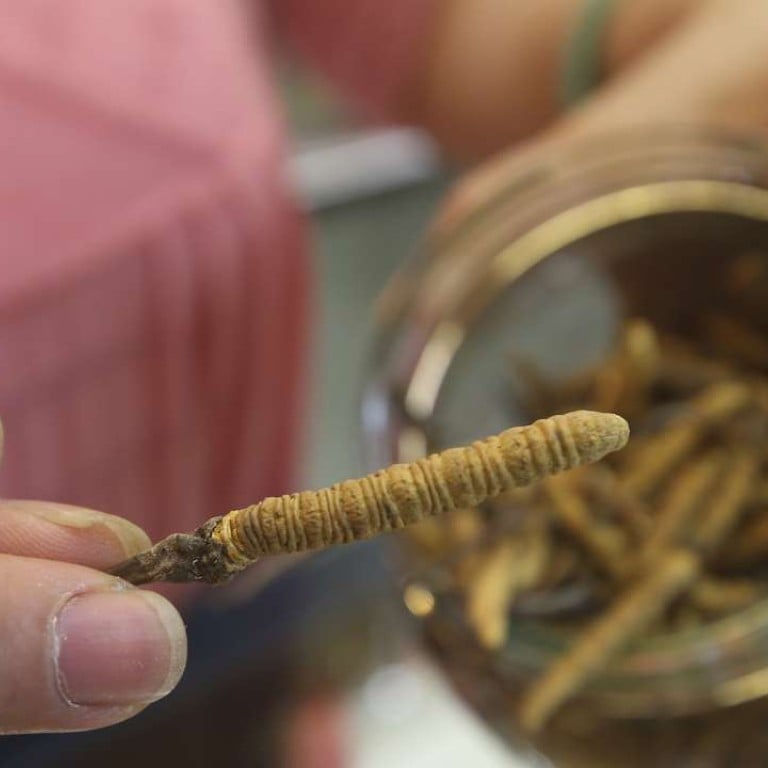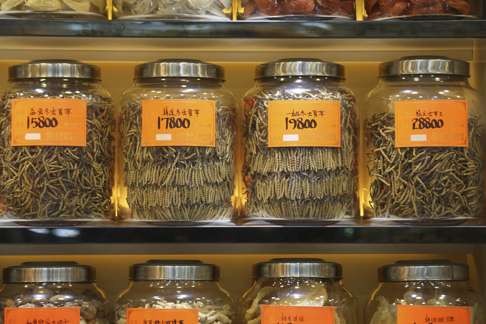
Is your Himalayan Viagra the real deal? Chinese medicine experts hope to guarantee it
Hong Kong scientists and retailers call for certification to ensure Cordyceps sinensis, known as caterpillar fungus, is the genuine article
Take a wander around Chinese pharmacies in Mong Kok and it’s hard not to notice caterpillar fungus, the tiny worm-like creatures crammed in huge jars that stand out among the vast and at times bizarre array of medicinal ingredients lining the shelves.
Talk with shop owners in the district and most say the fungus is either from Tibet, Sichuan or Qinghai. Some signs in front of the pharmacies declare “Governmental registered, quality guaranteed” while others state “Caterpillar fungus, originally from Tibet”.
But verifying the source and quality of traditional Chinese medicine sold in Hong Kong is not a transparent process.

“The modernisation of Chinese medicine is absolutely a revolution. We need full disclosure of the whole process of Chinese medicine produce, from the agricultural practise to the sales,” he says.
Keen to improve the industry, Wong was one of the backers of the Hong Kong Certification Scheme for Chinese Materia Medica, a initiative launched in 2015 to better govern the trade, testing and certification of the Chinese medicine industry by improving competitiveness and public confidence in Chinese medicine.
So far only a handful of participants have signed up to the government-backed scheme. There are about 3,200 pharmacies in Hong Kong selling Chinese medicine.
Caterpillar fungus is a good example of the need for industry transparency. The fungus enters the larva of a ghost moth, it grows inside until it kills its host before burrowing beneath the ground. As the snows retreat, a small shoot grows out from the shell of the dead larva.

One of the earliest references to the health benefits of the fungus was recorded in Ben Cao Cong Xin, a traditional Chinese medicine book that was published in 1757. It described the fungus as “mild and calm in nature, saying it strengthens lung and kidney functions, stops bleeding, dissolves phlegm, stops coughing.”
Its “miracle” claims today include that it is a year-round strengthening tonic for any age group, male or female, that improves liver and kidney function, preserves cardiac vascular health, treats cancer and boosts the immune system.

On the Tibetan plateaus where most of it is harvested, environmentalists say it’s on the brink of extinction, unable to cope with rising demand (two researchers from the University of Massachusetts’ biology department wrote a paper in 2013 in Biological Conservation, saying that the impact of trade and climate change is speeding the rarity of the parasitic fungus at a startling rate).
A valuable source of income for rural Tibetans who harvest it from May to July, the “gold rush” is also attracting outsiders who flood to the area to gather the cordyceps.
Chinese medicine experts in Hong Kong, Wong included, fear the huge demand is feeding a market in fake fungus.

Lin Zhixiu, a professor of Chinese medicine at the Chinese University of Hong Kong, Lin says the demand for cordyceps has encouraged “black-hearted” merchants to increase their profits by adulterating or faking the fungus.
“Though it may be better than the mainland, there are sellers adding fake or adulterated cordyceps to their jars in Hong Kong.”
He says more information needs to be added to the labelling on jars to better inform customers.
“The information shared by customers and small pharmacy owners is not transparent – it’s simply based on the little tags on jars.”
There’s good reason for concern. The Chinese medicine industry was shaken in February when the China Food and Drug Administration(CFDA) issued a consumer reminder on products of cordyceps which were found to exceed the safe level of arsenic, meaning that long-time consumption may be harmful to health.
Retailers have been slow to join the government-backed certification scheme, but this has not affected Wong’s passion for Chinese medicine.

“Making the best of medicinal materials is the core of developing Chinese medicine industry.”
Professor P.C. Shaw of the Chinese University of Hong Kong says he can help with verifying the quality of the fungus, having developed a technique for checking the presence of cordyceps DNA in a sample.
“Our aim is to authenticate cordyceps in the field or in the herbal shops,” says Shaw.
Lin Yi Tiu who works at Top Century Medicines Pharmacy in Tsim Sha Tsui, says flagging tourism combined with China’s crackdown on corruption have hurt business.
“Sales have dropped and Xi Jinping’s anti-corruption movement is one of the reasons. Fewer people send pricey gifts.”
